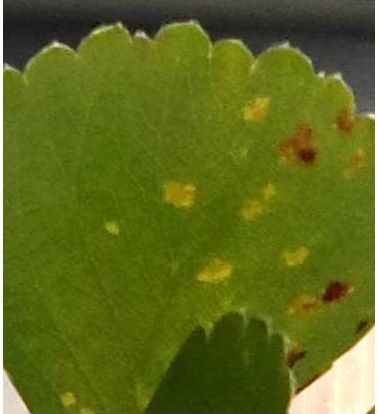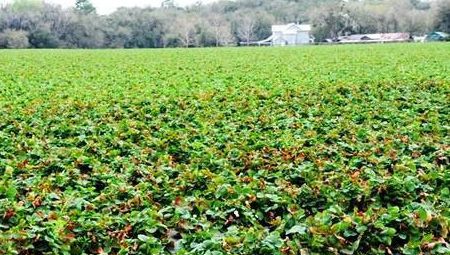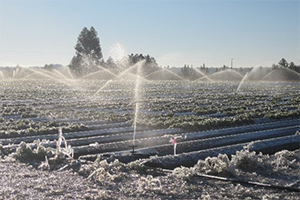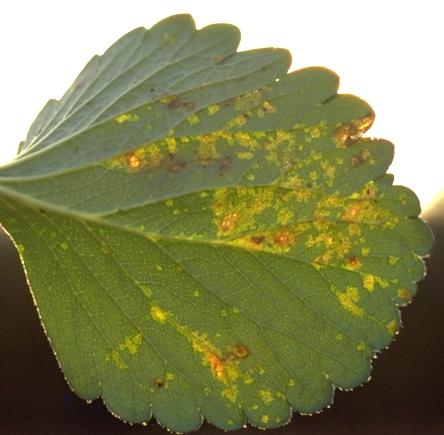Lisa DeVetter, Extension Team Member, WSU and Vance Whitaker, Demonstration Breeder and Statistical Genetics Team Leader, University of Florida
Angular leaf spot (ALS) is a major bacterial disease of cultivated strawberry (Fragaria × ananassa) caused by Xanthomonas fragariae (Kennedy and King, 1960 and 1962a). The pathogen colonizes strawberry leaves, thereby reducing the overall productivity and yields of affected plants. Symptoms of the disease include small, water-soaked lesions on the underside of leaves that eventually enlarge to form angular spots that are demarcated by leaf veins (Figure 1). At the beginning stages of infection, the small lesions appear translucent when viewed with transmitting light, but appear dark green when viewed without additional supplemental light. This distinction can be important in identifying the disease. Lesions can emit a bacterial ooze under conditions of high humidity and this ooze provides secondary inoculum for the spread of the pathogen. As the severity of infection increases, foliar lesions enlarge, coalesce, become visible from the surface of leaves, and the affected tissues undergo necrosis (i.e., tissue death). Damaged leaves eventually take on a tattered appearance, spreading across an entire field (Figure 2). Angular leaf spot can become systemic in a plant and may also infect the sepals adjacent to the fruit, causing the calyx to desiccate and darken. Although direct damage to the fruit is not caused by this pathogen, manifestation of symptoms on the calyx can reduce the marketability of fruit.

Photo: Jack Roach.
Angular leaf spot was first reported in Minnesota in 1960 (Kennedy and King, 1960). Although the impact of the disease is significant worldwide, it especially affects fresh strawberry production in Florida, the second largest national producer, with production in 2014 estimated at 116,000 U.S. tons of fruit from 10,900 acres [National Agriculture Statistics Services (NASS), 2015]. The disease routinely causes a total yield loss of up to 7.4 percent by weight during the winter season and 8.6 percent loss in marketable yield due to lesions on fruit calyces (Roberts et al., 1997). The annual estimated cost to the industry is $17 million during winters with multiple hard freezes.

bronzing and tattering of the leaves. Photo: Natalia Peres.
This bacterium is spread by several methods. In subtropical production regions like Florida, primary inoculum is likely from asymptomatic transplants with latent infections (Roberts et al., 1996). Additionally, overhead irrigation for establishment of transplants and frost protection is intensively practiced in Florida, which exacerbates the spread of ALS (Figure 3). Elsewhere, ALS is spread by rainfall to new sites of infection and spread across a field.
Few viable options exist for the management of ALS. Growers are advised to plant certified planting material from reputable nurseries that are free of ALS. Infected plants can be physically removed from a planting, but this control strategy is difficult to implement at a commercial scale. Similarly, avoiding the spread of secondary inoculum is challenging for Florida growers, as overhead irrigation is essential for establishment and freeze protection in this region. Chemical control options are available through copper formulations or acibenzolar-s-methyl, but these products have limited efficacy, might damage the strawberry plant through phytotoxic effects, and are seldom used (Mertely et al., 2010).
Although there are presently no viable management options to mitigate the devastation of ALS, tools that can help the strawberry industry overcome this disease exist through the use of plant genetics, and particularly, DNA-informed breeding. This is where the efforts of Vance Whitaker, his team of allied scientists, and RosBREED come into action.

inoculum of the angular leaf spot bacteria. Photo: Vance Whitaker.
One of the most powerful tools against ALS is genetic resistance to the disease. Commercial cultivars of strawberry presently do not have any resistance to ALS and only a few cultivars exhibit minor tolerance. Just this year, Whitaker and his team identified FaRXf1, a single locus identified in wild accessions US4808 and US4809 that confers resistance to four types
of X. fragariae (Roach et al., 2016). The resistance allele at this locus is being introgressed into Florida germplasm via DNA-informed breeding approaches. Several preliminary DNA tests have already been developed as a result of this locus’ discovery and are being used for marker-assisted seedling selection in Dr. Whitaker’s breeding program. These DNA tests have been made available to fellow RosBREED scientist Nahla Bassil (USDA-ARS, National Clonal Germplasm Repository in Corvallis, Oregon). As a result, Bassil can test other RosBREED strawberry material that breeders submit to her, accelerating the process of breeding for ALS resistance.
Currently, a DNA test is being perfected so that strawberry breeders around the world can test for ALS resistance. All of this demonstrates the power of collaborative research and breeding, which provides an important foundation for RosBREED to develop cultivars with resistance to diseases that threaten our important rosaceous crops.
References:
Kennedy, B.W. and T.H. King. 1960. Angular leafspot, a new disease of strawberry. Phytopathology 50:641–642.
Kennedy B.W. and T.H. King. 1962a. Angular leaf spot of strawberry caused by Xanthomonas fragariae sp. nov. Phytopathology 52:873–875.
Kennedy, B.W. and T.H. King. 1962b. Studies on epidemiology of bacterial angular leafspot on strawberry. Plant Dis Report 46:360–363.
Mertely J., T. Seijo, R. Martin, D.N. Moore, and N.A. Peres. 2010. Evaluation of products for angular leaf spot control in annual strawberry, 2009–10. Plant Dis. Manag. Rep. 4:SMF052.
NASS. 2015. Noncitrus Fruits and Nuts 2014 Summary. United States Department of Agriculture. Accessed 5 May 2016 at: http://usda.mannlib.cornell. edu/MannUsda/viewDocumentInfo.do?documentID=1113.
Roach, J.A., S. Verma, N.A. Peres, A.R. Jamieson, W.E. van de Weg, M.C.A.M Blink, N.V. Bassil, S. Lee, and V.M. Whitaker. 2016. FaRXf1: a locus conferring resistance to angular leaf spot caused by Xanthomonas fragariae in octoploid strawberry. Theor. Appl. Genet. pp 1-11. DOI 10.1007/s00122-016-2695-1.
Roberts, P.D., J.B. Jones, C.K. Chandler, R.E. Stall, and R.E. Berger. 1996. Survival of Xanthomonas fragariae on strawberry in summer nurseries in Florida detected by specific primers and nested polymerase chain reaction. Plant Dis. 80:1283–1288.
Roberts, P.D., R.D. Berger, J.B. Jones, C.K. Chandler, and R.E. Stall. 1997. Disease progress, yield loss, and control of Xanthomonas fragariae on strawberry plants. Plant Dis. 81:917–921.

